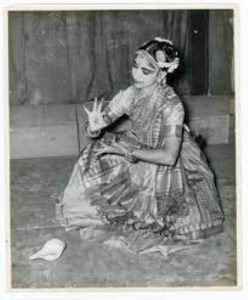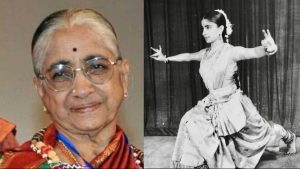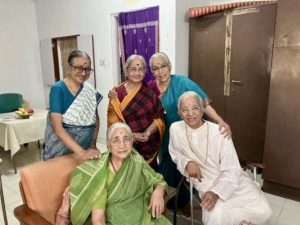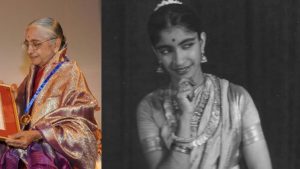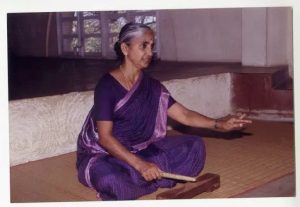The Silent Torchbearer of Kalakshetra: Remembering Sarada Hoffman
Alladi Sarada, later Sarada Hoffman (1929–2025), affectionately known as Sarada Teacher or Chinna Sarada, was more than a Bharatanatyam exponent—she was a visionary pedagogue who shaped the way classical dance is taught and performed across the globe. As a senior faculty member at Kalakshetra Foundation, she played a pivotal role in standardising what is now widely regarded as the Kalakshetra methodology, one of the most respected pedagogical systems for Bharatanatyam.
Her passing on 14 September 2025 in California at the age of 96 marked the end of an era for the world of classical Indian dance. Yet, her legacy continues to live on through the countless students she mentored, the method she codified, and the unwavering values she embodied throughout her life.
Born into a Cultural Epicentre
Born on 15 June 1929 in the spiritual and intellectual hub of the Theosophical Society campus in Adyar (Chennai), Alladi Sarada was immersed in a rich atmosphere of art, philosophy, and discipline from an early age. Her journey in Bharatanatyam began at Kalakshetra, founded by the legendary Rukmini Devi Arundale, where she later became a key figure.
Despite her towering contributions, Sarada never allowed the title “Guru” to precede her name. She insisted on being called “Sarada Teacher,” a humble yet powerful reminder of her devotion to teaching and learning. Her peers and students affectionately referred to her as Chinna Sarada, distinguishing her from the elder scholar S. Sarada, also part of the Kalakshetra family.
Codifying the Kalakshetra Style
Under Rukmini Devi’s visionary leadership, Kalakshetra aimed to bring classical dance into a structured educational framework. Sarada Teacher became one of its foremost architects. Her own dance technique was marked by uncompromising precision, aesthetic restraint, and expressive clarity, values she infused deeply into the teaching system.
She was instrumental in unifying various regional and traditional training styles into a cohesive curriculum that could be passed down systematically. The result was the Kalakshetra methodology—a codified approach that focuses on clean lines, spiritual depth, and disciplined training, now seen as a global benchmark for Bharatanatyam instruction.
Sarada Teacher was Rukmini Devi’s model of the ideal dancer-teacher—someone who could translate inner spiritual clarity into physical form. Through her commitment to form, technique, and integrity, she laid a strong foundation that has guided generations of dancers.
A Generation of Disciples
Sarada Teacher’s influence stretched across multiple generations of Bharatanatyam artists. Her early disciples include stalwarts like: Yamini Krishnamurthy, C.V. Chandrasekhar, Adyar Lakshman, V.P. Dhananjayan, Shanta Dhananjayan, Savitri Jagannatha Rao, Krishnaveni Lakshmanan, Ambika Buch, Kala Ramesh, Neela Satyalingam and Balasundari Prathalingam (Sri Lanka)
Even in later years, she remained a vital presence, mentoring renowned Kalakshetra alumni like G. Narendra, P.T. Narendran, and the duo Shijith Nambiar and Parvathi Menon.
Her dedication was not just to perfecting technique but to building character and instilling discipline. As a teacher, she rarely sought the spotlight for herself, often allowing her students to shine. Even when cast in major roles by Rukmini Devi—such as Parvathi in Kumarasambhavam or Manthara in Sri Rama Vana Gamanam—she always retained the humility of a teacher first.
Remembering her fondly Padmashri Ananda Shankar Jayant said, “Sharada Hoffman was my Bharatanatyam teacher, at Kalakshetra. A strict disciplinarian she trained us meticulously, making sure our dance grammar was impeccable.
Sharada teacher and NS Jayalakshmi (Jaya Teacher) were the two eyes of Rukmini Devi Arundale. Together they set in place the distinct Kalakshetra pedagogy that is now followed globally. These great teachers served a full lifetime in service of the arts.”
Dr Sandhya Purecha, Chairperson Sangeet Natak Akademy in her condolence message said, “She was the architect of Kalakshetra and a true torchbearer of Rukmini Devi’s legacy. Her legacy lives on in the wealth of students that she has nurtured and her invaluable contribution to Indian dance. My deepest condolences to her family, loved ones and students.” Dr Uma Rele, Principal Nalanda Nritya Kala Mahavidhyala said, “Last legend of Rukmini Devi ‘s era of Dancers who trained under her tutelage has gone leaving her legacy continued, deeply sadden with this loss.”
Choreographic Contributions and Recognitions
While teaching was her main passion, Sarada Teacher also explored choreography. Her works include folk forms such as Naatu Padal, Kummi, Kolattam, and Tiruppugazh verses. Her major choreographic work was Murugan Thiruvarul, a full-length dance drama created during her time at Kalakshetra. Unfortunately, it wasn’t regularly performed and remains one of Kalakshetra’s lesser-known treasures.
Despite her low public profile, she was recognised by the Indian arts community for her immense contributions: In 1996, she received the Sangeet Natak Akademi Award, India’s highest honour in the performing arts. She was the first recipient of the Rukmini Devi Medal for Excellence in the Arts, instituted by the Centre for Contemporary Culture, New Delhi. Other notable honours include awards from Sankarabharanam, curated by Venkatakrishnan Mama, and Natyarangam of Narada Gana Sabha.
A Life Anchored in Humility and Excellence
Sarada Teacher spent her final years in California, under the care of her children, Geetha Hoffman and Krishna Hoffman, and daughter-in-law Paulomi Pandit, also her student. Her quiet exit from public life mirrored her personality—modest, dignified, and inwardly focused.
Though accolades were few, those who knew her work understand that her true contribution lies in the lives she touched and the lineage she helped forge. Her name may not be etched in glamour, but her principles form the bedrock of Bharatanatyam education as we know it today.
Legacy for the Future
In an age where rapid digitisation risks flattening traditional knowledge systems, Sarada Teacher’s work stands as a template for structured, spiritually anchored learning. Her precision, pedagogy, and humility serve as a reminder that classical arts must be preserved not only in performance but in method and mindset.
Her life is a call to current and future educators in the arts—to focus not on fame, but on depth, discipline, and devotion. As institutions around the world seek authenticity in preserving intangible cultural heritage, Sarada Hoffman’s Kalakshetra methodology continues to shine as a timeless guide.
Sarada Teacher’s legacy is not in monuments or museums, but in mudras, footwork, and generations of dancers who silently carry her teaching in every movement they perform. May her soul rest in divine peace.
Sandip Soparrkar holds a doctorate in world mythology folklore from Pacific University USA, an honorary doctorate in performing arts from the National American University, He is a World Book Record holder, a well-known Ballroom dancer and a Bollywood choreographer who has been honored with three National Excellence awards, one National Achievement Award and Dada Saheb Phalke award by the Government of India. He can be contacted on sandipsoparrkar06@gmail.com


